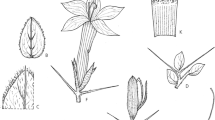Summary
A survey of the tribe Justicieae from the Caatinga biome, in the State of Bahia, revealed the following four new species of Justicia (Acanthaceae): J. angustissima, J. attenuata, J. chlamidocalyx and J. jacuipensis. J. attenuata and J. jacuipensis are known only from the types; the latter is considered Critically Endangered (CR) because the area where it was collected has been flooded since the construction of the Pedra do Cavalo dam and the region around this area has been extensively disturbed. J. angustissima and J. chlamidocalyx were found in six locations. They have a wide distribution in Central Bahia and the conservation status of both species should be classified as Least Concern (LC). The four species are described and illustrations and comments are provided.
Resumo
O levantamento de Justicieae do Bioma Caatinga no Estado da Bahia propiciou o reconhecimento de quatro espécies novas de Justicia (Acanthaceae): J. angustissima, J. attenuata, J. chlamidocalyx e J. jacuipensis. J. attenuata e J. jacuipensis são conhecidas apenas pelo material-tipo; a última pode ser considerada Criticamente Ameaçada (CR), pois a área onde foi coletada encontra-se inundada pela represa Pedra do Cavalo e seu entorno encontra-se extensamente antropizado. J. angustissima e J. chlamidocalyx foram encontradas em seis localidades, mas apresentam uma distribuição relativamente ampla no interior da Bahia e o estado de conservação delas inspira menor preocupação (LC). As quatro espécies são descritas, ilustradas e comentários são apresentados para cada uma delas.



Similar content being viewed by others
References
Bremekamp, C. E. B. (1948). Notes on the Acanthaceae of Java. Verh. Kon. Ned. Akad. Wetensch., Afd. Natuurk., Sect. 2, 45: 1 – 78.
Côrtes, A. L. A. (2009). Justicieae (Acanthaceae) do Bioma Caatinga do Estado da Bahia. Dissertação de Mestrado. Universidade Estadual de Feira de Santana, Feira de Santana.
Daniel, T. F. (1998). Pollen morphology of Mexican Acanthaceae: diversity and systematic significance. Proc. Calif. Acad. Sci. 50: 217 – 256.
____(2002). New and reconsidered Mexican Acanthaceae IX. Justicia. Proc. Calif. Acad. Sci. 53: 37 – 49.
____, McDade, L. A., Manketelow, M. & Kiel, C. A. (2008). The “Tetramerium lineage” (Acanthaceae: Acanthoideae: Justicieae): delimitation and intra-lineage relationships based on cp and nrITS sequence data. Syst. Bot. 33: 416 – 436.
Erdtman, G. (1960). The acetolysis method: a revised description. Svensk Bot. Tidskr. 39: 561 – 564.
Ezcurra, C. (2002). El género Justicia (Acanthaceae) en Sudamérica Austral. Ann. Missouri Bot. Gard. 89: 225 – 280.
Graham, V. A. W. (1988). Delimitation and infra-generic classification of Justicia (Acanthaceae). Kew Bull. 43: 551 – 624.
IUCN (2001). IUCN Red List Categories and Criteria: Version 3.1. IUCN Species Survival Commission. IUCN, Gland, Switzerland & Cambridge, UK.
Leonard, E. C. (1958). The Acanthaceae of Colombia. Contr. U.S. Natl. Herb. 31: 487 – 645.
McDade, L. A. & Moody, M. L. (1999). Phylogenetic relationships among Acanthaceae: evidence from noncoding trnL-trnF chloroplast DNA sequences. Amer. J. Bot. 86: 70 – 80.
____, Daniel, T. F., Masta, S. E. & Riley, K. M. (2000a). Phylogenetic relationships within the tribe Justicieae (Acanthaceae): evidence from molecular sequences, morphology, and cytology. Ann. Missouri Bot. Gard. 87: 435 – 458.
____, Masta, S. E., Moody, M. L. & Waters, E. (2000b). Phylogenetic relationships among Acanthaceae: evidence from two genomes. Syst. Bot. 25: 106 – 121.
____, Daniel, T. F. & Kiel, C. A. (2008). Toward a comprehensive understanding of phylogenetic relationships among lineages of Acanthaceae s.l. (Lamiales). Amer. J. Bot. 95: 1136 – 1152.
Nees, C. G. (1847). Acanthaceae. In: C. F. P. Martius, A. G. Eichler & I. Urban (eds), Flora brasiliensis 9: 1 – 164. Leipzig, Wien, Munchen.
Profice, S. R., Kameyama, C., Côrtes, A. L. A., Braz, D. M., Indriunas, A., Vilar, T., Pessoa, C., Ezcurra, C. & Wasshausen, D. (2010). Acanthaceae. In: Lista de Espécies da Flora do Brasil. Jardim Botânico do Rio de Janeiro. (http://floradobrasil.jbrj.gov.br/2010/FB000033). Accessed 11.09.2011.
Punt, W., Hoen, P. P., Blackmore, S., Nilsson, S. & Le Thomas, A. (2007). Glossary of pollen and spore terminology. Rev. Palaeobot. Palynol. 143: 1 – 81.
Queiroz, L. P., Conceição, A. A. & Giulietti, A.M. (eds). (2006). Diversidade e caracterização das fanerógamas do semi-árido brasileiro. Instituto do Milênio do Semi-Árido, vol.1. APNE, Recife.
Raj, B. (1961). Pollen morphological studies in the Acanthaceae. Grana Palynol. 3: 3 – 108.
Wasshausen, D. C. (1992). Three new species of Justicia (Acanthaceae) from Brazil. Proc. Biol. Soc. Wash. 105: 664 – 673.
Acknowledgements
This work is part of the M.Sc. thesis of the first author, which was carried out in the Postgraduate Program in Botany at the Universidade Estadual de Feira de Santana, with a fellowship from CNPq. We thank IMSEAR and PPBio do Semi-árido for funding field work and visits to herbaria, Dr Francisco de Assis Ribeiro dos Santos and Ms Ricardo Landim Bormann de Borges for their helpful discussions about palynology, and Gisele Pinto Rocha for assistance with the SEM. We are also grateful to Jorge Fontella Pereira for the Latin diagnoses, Dieter Wasshausen, Cíntia Kameyama and Thomas F. Daniel for helping with the identifications, Dieter Wasshausen for reviewing a previous version of the manuscript, and the curators of the herbaria that were visited during this study (ALCB, CEPEC, HRB, MBM, RB, SP, SPF, UB). AR is supported by a PQ-2 grant (CNPq).
Author information
Authors and Affiliations
Corresponding author
Rights and permissions
About this article
Cite this article
Andrade Côrtes, A.L., Rapini, A. Four new species of Justicia (Acanthaceae) from the Caatinga biome of Bahia, Brazil. Kew Bull 66, 453–461 (2011). https://doi.org/10.1007/s12225-011-9295-7
Accepted:
Published:
Issue Date:
DOI: https://doi.org/10.1007/s12225-011-9295-7




